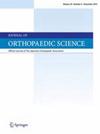Patellar height changes sequentially after medial open wedge high tibial osteotomy: Evaluation using shear wave elastography
IF 1.5
4区 医学
Q3 ORTHOPEDICS
引用次数: 0
Abstract
Background
This study was performed to evaluate changes in patellar tendon tissue after medial open wedge high tibial osteotomy (MOWHTO) using shear wave elastography (SWE) and to clarify the factors contributing to patellar height changes after MOWHTO.
Methods
The study cohort comprised 24 knees of 24 patients. Patellar tendon length, thickness, and elasticity were evaluated using SWE preoperatively, 2 weeks postoperatively, and 3, 6, and 12 months postoperatively. The Caton–Deschamps index (CDI) was also measured at these time points. Lower limb alignment and factors related to sequential changes in patellar height were evaluated.
Results
The CDI was significantly different between preoperatively and 2 weeks postoperatively and between 2 week postoperatively and 3, 6, and 12 months postoperatively (p < 0.05 for all) The patellar tendon length at 12 months postoperatively was significantly shorter than that at 2 weeks postoperatively. The postoperative patellar tendon thickness was thicker than preoperative patellar tendon at all sites. The postoperative patellar tendon thickness significantly increased from preoperatively at middle and distal sites. The only factor associated with Δpre-post2WCDI (preCDI − post2WCDI) was ΔMPTA(medial proximal tibial angle) (postoperative MPTA – preoperative MPTA) (p = 0.042). The significant predictor of Δpost2W-post12MCDI was Δpost2W-post12 M distal elasticity (p = 0.022).
Conclusion
Patellar height changed sequentially after MOWHTO. The factors that caused patellar height change were related to the change in patellar tendon quality after OWHTO.
内侧开放式楔形高胫骨截骨术后髌骨高度的连续变化:使用剪切波弹性成像进行评估。
背景:本研究旨在使用剪切波弹性成像(SWE)评估内侧开放式楔形胫骨高位截骨术(MOWHTO)后髌腱组织的变化,并阐明导致MOWHTO术后髌骨高度变化的因素:研究队列包括 24 名患者的 24 个膝关节。使用 SWE 对术前、术后 2 周、术后 3、6 和 12 个月的髌腱长度、厚度和弹性进行了评估。在这些时间点还测量了卡顿-德尚指数(CDI)。对下肢对齐情况以及与髌骨高度连续变化相关的因素进行了评估:结果:CDI 在术前与术后 2 周之间、术后 2 周与术后 3、6 和 12 个月之间存在明显差异(p 结论:髌骨高度在术后 2 周、术后 3 个月、术后 6 个月和术后 12 个月之间依次发生变化:髌骨高度在 MOWHTO 术后发生了连续变化。导致髌骨高度变化的因素与OWHTO术后髌腱质量的变化有关。
本文章由计算机程序翻译,如有差异,请以英文原文为准。
求助全文
约1分钟内获得全文
求助全文
来源期刊

Journal of Orthopaedic Science
医学-整形外科
CiteScore
3.00
自引率
0.00%
发文量
290
审稿时长
90 days
期刊介绍:
The Journal of Orthopaedic Science is the official peer-reviewed journal of the Japanese Orthopaedic Association. The journal publishes the latest researches and topical debates in all fields of clinical and experimental orthopaedics, including musculoskeletal medicine, sports medicine, locomotive syndrome, trauma, paediatrics, oncology and biomaterials, as well as basic researches.
 求助内容:
求助内容: 应助结果提醒方式:
应助结果提醒方式:


